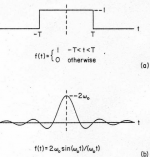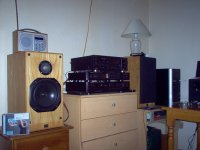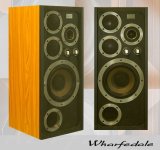Hi scottjoplin!
Yes, and it follows that the ultimate test would be to ask a loudspeaker to accurately reproduce a square wave.
To do this accurately the speaker would have to have a perfect frequency and phase response.
Speakers with good transient response would do best in such a test but, truth be told, all real-life speakers will mangle a square wave.
And crossovers, apart from first order, would appear to carry a lot of the blame!
Yes, and it follows that the ultimate test would be to ask a loudspeaker to accurately reproduce a square wave.
To do this accurately the speaker would have to have a perfect frequency and phase response.
Speakers with good transient response would do best in such a test but, truth be told, all real-life speakers will mangle a square wave.
And crossovers, apart from first order, would appear to carry a lot of the blame!
No offense taken, my friend. But to you and others. Let me explain not how loudspeakers work. I know that stuff.
But how the Universe and Mathematics works.
There IS a fullrange driver that works pretty well. It's called headphones:
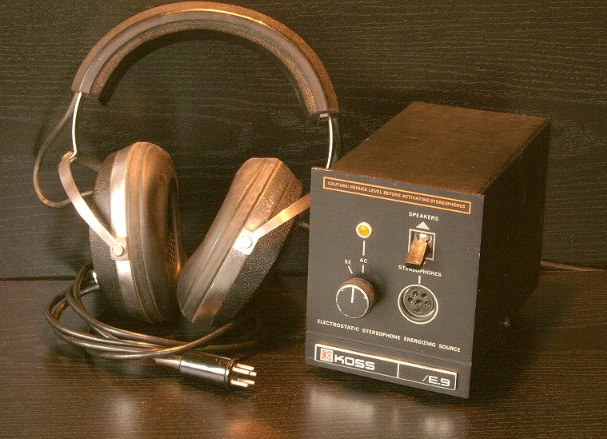
A real room speaker finds life much harder. A 1" tweeter can scarcely move enough air for realistic bass. So we split the frequency range, and this one is a beaut IMO:
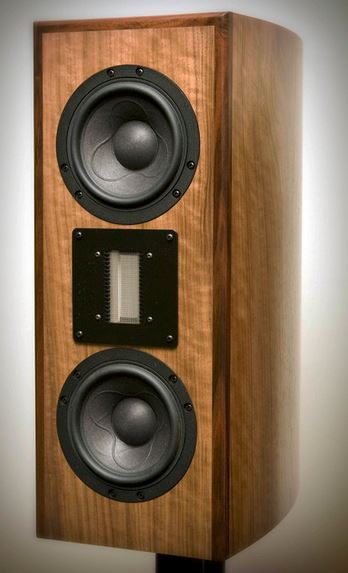
In fact the most successful of these sorts of designs use subwoofers to spare the mids excursion. Because excursion is the main element of non-linearity and distortion. Even wall mount for that freebie of 6dB room gain.
There are many elements to a good loudspeaker. But in the end, it is all an illusion. Nothing is perfect. We trade off distortion against transient ability. We trade off dispersion against room acoustics. I could go on.
But IMO, a good 3 way knocks the socks off any two way. A good room acoustic helps. Filters, well pick your poison...
The good news is that some designs work pretty well: Classic monitor designs?
That thread is a goldmine.
But how the Universe and Mathematics works.
There IS a fullrange driver that works pretty well. It's called headphones:
A real room speaker finds life much harder. A 1" tweeter can scarcely move enough air for realistic bass. So we split the frequency range, and this one is a beaut IMO:
In fact the most successful of these sorts of designs use subwoofers to spare the mids excursion. Because excursion is the main element of non-linearity and distortion. Even wall mount for that freebie of 6dB room gain.
There are many elements to a good loudspeaker. But in the end, it is all an illusion. Nothing is perfect. We trade off distortion against transient ability. We trade off dispersion against room acoustics. I could go on.
But IMO, a good 3 way knocks the socks off any two way. A good room acoustic helps. Filters, well pick your poison...
The good news is that some designs work pretty well: Classic monitor designs?
That thread is a goldmine.
Hi scottjoplin!
Yes, and it follows that the ultimate test would be to ask a loudspeaker to accurately reproduce a square wave.
To do this accurately the speaker would have to have a perfect frequency and phase response.
Speakers with good transient response would do best in such a test but, truth be told, all real-life speakers will mangle a square wave.
And crossovers, apart from first order, would appear to carry a lot of the blame!
To accurately reproduce a square wave the speaker first of all would need infinite bandwidth.
Once you've got that you can start worrying about what the crossover does.
People often use the term fast when they ar etalking about how quickly a cone starts & stops, but by definition fast is a measure of the frequency being reproduced. The higher the frequency the faster a driver moves.
A horn improves the coupling of the high resistance driver cone with the low acoustic resitantsnce of the air and leads to smaller excursions for the same SPL so not having to move as far can start & stop quicker. But they have other issues. Speaker design is all about the compromises you can best live with.
dave
A horn improves the coupling of the high resistance driver cone with the low acoustic resitantsnce of the air and leads to smaller excursions for the same SPL so not having to move as far can start & stop quicker. But they have other issues. Speaker design is all about the compromises you can best live with.
dave
It's an interesting fact that series (aka serial) crossovers can easily approach infinite bandwidth. We actually usually model filters with polynomial functions. LR4 or whatever. Our usual filters try and contain the response in a square box.To accurately reproduce a square wave the speaker first of all would need infinite bandwidth.
Once you've got that you can start worrying about what the crossover does.
Series crossovers approach a more spread out Gaussian response. I'd need a few pages to explain it. Thing is, the more you try to contain the frequency response in a square box, the more the time domain spreads out. It's just Maths or the Universe. When you model a crossover you are usually using Fourier Transform. Well, it's not the only game in town. AFAIK, there are an infinite set of Orthogonal Functions.
Planet10, aka our lovely Dave, mentions low acoustic resistance. The fact is your average non-hornloaded driver hardly couples to the air beyond 1%. Most tweeters would work exactly the same in the vacuum of space as in the air. I think the whole fullrange argument mostly involves the fact that cones seem to work better than almost anything else.
Along with the Sinc function, some of my faves below. I love that Wharfedale E70. It's so cool.
Attachments
And surely Dave that starting and stopping quickly is what's behind reproducing the micro-detail?
At least partly.
dave
Just to be sure there are no misunderstanding, do you mean the OP?the more stupid the topic, the more replies it attracts.
I am under the impression that most perceived detail or texture of music comes from about 5k to 10k Hz. If so does it mean that we should put more money on tweeter when building a speaker if detail is the priority?
wrong! nothing comes out of this bandwidth.
Most perceived détails and enjoyment I calculated comes from 100 to 900 hz.
However if you miss the 5k-10k range the trumpets and high pitch sounds will be irritable and the whole system sound poor.
I use 2x250$ tweeters and to me they are just acceptable, but it does the job of covering the range at which the woofer beam and give a nice presence to the sound.
I am sure you can integrate 50$ tweeters without any issues. Focus on the best woofer possible which isn't going to beam at high frequencies and not sound thin under 1k.
wrong! nothing comes out of this bandwidth.
Most perceived détails and enjoyment I calculated comes from 100 to 900 hz.
However if you miss the 5k-10k range the trumpets and high pitch sounds will be irritable and the whole system sound poor.
I use 2x250$ tweeters and to me they are just acceptable, but it does the job of covering the range at which the woofer beam and give a nice presence to the sound.
I am sure you can integrate 50$ tweeters without any issues. Focus on the best woofer possible which isn't going to beam at high frequencies and not sound thin under 1k.
Would you say transient response too (which was to a degree implied)? Since the detail retrieval would be a function of how well the speaker follows the input signal, which would be the best measurements to use?At least partly.
Small details are inherent in any device that has high DDR. I know no way of measuring it other than with the well trained ear/brain.
dave
How would you know you're not falling into this trap:
Well, it's not called 'definition' for nothingRegardless, the OP asked a very specific question, so got a very specific answer, but long experience has taught me that when folks talk about how 'detailed', etc., a speaker is, invariably there's some peaking in the 6 to 10 kHz BW, often just a major peak around 7-8 kHz.
Doesn't matter if it's a 'FR' driver or a multi-way or how good/bad the rest of the speaker's BW is IME, we are very sensitive to sibilance and in small amounts can 'highlight'/bring sounds 'forward' a bit and of course if too much, then too distorted for comfort.
GM
Good question. The peaks Greg is taling about i call false detail.
Early on Julian Vereker said to me not to think about distrotion in the usual way (as in things added), but to consider a hif as an information processing system and fidelity was when a minimum of information was lost. What i listen for is whether information is there or not. If it is not there then the DDR is not high.
dave
Early on Julian Vereker said to me not to think about distrotion in the usual way (as in things added), but to consider a hif as an information processing system and fidelity was when a minimum of information was lost. What i listen for is whether information is there or not. If it is not there then the DDR is not high.
dave
Hi planet10!
You say, quote, that "the higher the frequency the faster a driver moves".
This statement deserves some analysis:
If we consider the reproduction of a pure sine wave then the the loudspeaker diaphragm will be in simple harmonic motion (SHM).
The maximum velocity in SHM occurs at the centre or equilibrium position of the vibration and is directly proportional to both the amplitude of the diaphragm motion and the frequency of its vibration.
In the reproduction of music, as frequency increases the amplitude of vibration will get smaller. This will mitigate against the increase in the maximum velocity caused by the increase in frequency.
I agree that frequency is likely to be the dominating factor, but wihout comparative amplitude data, I cannot be certain as to what extent it is dominant.
Perhaps there is someone out there who has done the calculations?
You say, quote, that "the higher the frequency the faster a driver moves".
This statement deserves some analysis:
If we consider the reproduction of a pure sine wave then the the loudspeaker diaphragm will be in simple harmonic motion (SHM).
The maximum velocity in SHM occurs at the centre or equilibrium position of the vibration and is directly proportional to both the amplitude of the diaphragm motion and the frequency of its vibration.
In the reproduction of music, as frequency increases the amplitude of vibration will get smaller. This will mitigate against the increase in the maximum velocity caused by the increase in frequency.
I agree that frequency is likely to be the dominating factor, but wihout comparative amplitude data, I cannot be certain as to what extent it is dominant.
Perhaps there is someone out there who has done the calculations?
Last edited:
To create a sine wave at twice the frequency and the same SPL requires only 1/4 the amount of cone excursion. The velocity would increase linearly with frequency if the excursion was constant, therefore for constant SPL the velocity is halved when the frequency is doubled.
Of course, this is assuming constant tones and a full range speaker. If we consider transient sounds and multi-way speakers where the tweeter has a much smaller surface area than the woofer, the velocity of the tweeter may well exceed that of the woofer in a passage of music.
To answer the OPs question:
I guess the 'detail' in a musical instrument is in the amplitude of the harmonics relative to the fundamental. This is what determines the timbre of a musical instrument and why music instruments sound different when they play the same note. So the 'detail' for a bass guitar would be in the midrange while the 'detail' for a cymbal will be in the upper treble.
Therefore retaining the 'detail' of a recording requires preserving the fundamental and harmonics of all instruments as they were originally recorded, not adding or removing any components. Flat frequency response (low linear distortion) is important to maintain the level of the harmonics relative to the fundamentals. It is also important that the speaker doesn't 'ring' at certain frequencies which would change the attack/decay of certain notes - this is a type of linear-distortion and is closely related to the frequency response. Low non-linear (harmonic) distortion is important so we don't add extra harmonics that didn't exist in the original recording. Low non-linear distortion (intermodulation distortion) is important so we don't add extra tones that are mathematical combinations of two different notes, that didn't exist in the original recording. If you accomplish all that, you will reproduce the recording faithfully neither losing any details nor adding extra false details that didn't exist before.
Altering the frequency response from flat may give the impression of enhanced 'detail' by increasing the amplitude of the harmonics of certain instruments therefore modifying their timbre, as might adding non-linear distortion. This could be subjectively pleasing to listen to however this will not be a faithful reproduction of the original recording.
Of course, this is assuming constant tones and a full range speaker. If we consider transient sounds and multi-way speakers where the tweeter has a much smaller surface area than the woofer, the velocity of the tweeter may well exceed that of the woofer in a passage of music.
To answer the OPs question:
I guess the 'detail' in a musical instrument is in the amplitude of the harmonics relative to the fundamental. This is what determines the timbre of a musical instrument and why music instruments sound different when they play the same note. So the 'detail' for a bass guitar would be in the midrange while the 'detail' for a cymbal will be in the upper treble.
Therefore retaining the 'detail' of a recording requires preserving the fundamental and harmonics of all instruments as they were originally recorded, not adding or removing any components. Flat frequency response (low linear distortion) is important to maintain the level of the harmonics relative to the fundamentals. It is also important that the speaker doesn't 'ring' at certain frequencies which would change the attack/decay of certain notes - this is a type of linear-distortion and is closely related to the frequency response. Low non-linear (harmonic) distortion is important so we don't add extra harmonics that didn't exist in the original recording. Low non-linear distortion (intermodulation distortion) is important so we don't add extra tones that are mathematical combinations of two different notes, that didn't exist in the original recording. If you accomplish all that, you will reproduce the recording faithfully neither losing any details nor adding extra false details that didn't exist before.
Altering the frequency response from flat may give the impression of enhanced 'detail' by increasing the amplitude of the harmonics of certain instruments therefore modifying their timbre, as might adding non-linear distortion. This could be subjectively pleasing to listen to however this will not be a faithful reproduction of the original recording.
Last edited:
- Status
- This old topic is closed. If you want to reopen this topic, contact a moderator using the "Report Post" button.
- Home
- Loudspeakers
- Multi-Way
- Where do most perceived detail come from, tweeter or woofer?
